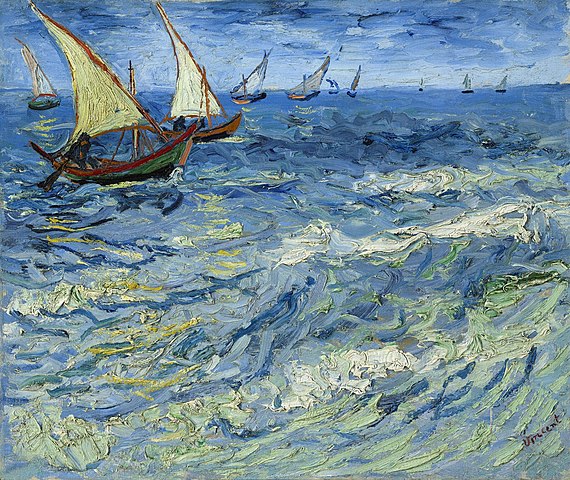Summer, this sweet season when the light of day never seems to want to leave, where the heat caresses our bodies and the nights are poetic and starry. It is a period conducive to the rediscovery of our regions and the world and which has greatly inspired artists since the dawn of time. Fine observers and admirers, they transport us in each of their works and in their own conception of reality. Because each painting has its own story and clings to our memories, here is a love letter to summer via an analysis of 5 paintings.
Seascape near Saintes-Maries-de-la-MerVincent van Gogh (1888)
Legend has it that the Mediterranean and its bright colors greatly inspired Van Gogh throughout his career: we would have found grains of sand embedded in this particular canvas! In this work, Van Gogh plays with shades of blue and the large brushstrokes leaning on the canvas give relief and consistency to the story he wants to tell. It is that of a thick, crushing sea, which is reinforced by the absence of shore, plunging us into the heart of the scene. In addition to the materiality they bring, the brushstrokes, in particular the dynamic gesture, allow the spectator to question themselves, to project themselves: the high point of view suggests that the scene is observed from the deck of a ship , as we see a dozen of them floating on the horizon. No difficulty then in mentally imagining these boats present on the water in confrontation with the sea and the wind whistling in their sails. You can almost imagine the seagulls flying above the boats and the waves continuing their song. Thanks to a meticulous work of tonality, the painter succeeded in capturing an accurate and realistic light of the scene. If this painting is reminiscent of summer, it is not only due to the palette of colors which suggests the sun playing with the waves, even in the open sea. It is also because it represents the strength of a nature in its peak in the hottest season of the year.
Landscape at CollioureHenri Matisse (1905)
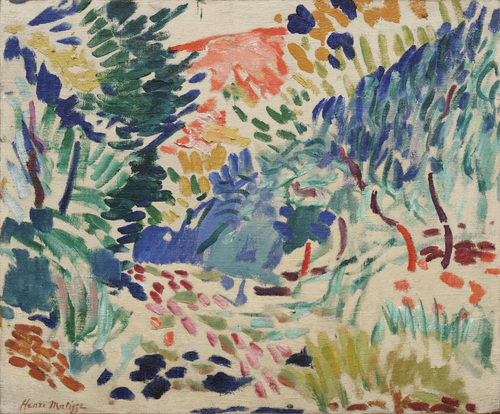
At the gates of Spain and the Mediterranean, the town of Collioure is represented here by Matisse as an allegory of summer, a quasi-abstract work all in primary colors. Above all, it illustrates the perception of Collioure through the eyes of Matisse, at a time in his life when the artist was going through a period of introspection, resulting on the canvas in the desire to experiment with new styles, to get closer little by little Fauvism. The perfect combination of bright colors and certain gestures, even a dynamism in the brushstrokes, in a disorganized and unfinished spirit, testifies to the spontaneity of summer and its fleeting nature. The season is shown to us here through nature, wild vegetation, freed from man and the onslaught of autumn and winter. Where is Collioure? The city, a pretext for the title, is hidden behind the formidable vegetation that inspired the painter. Landscape at Collioure illustrates beauty in disorder and gives meaning to what seems to be insignificant.
Olive trees with the Alpilles in the background, Vincent van Gogh (1889)
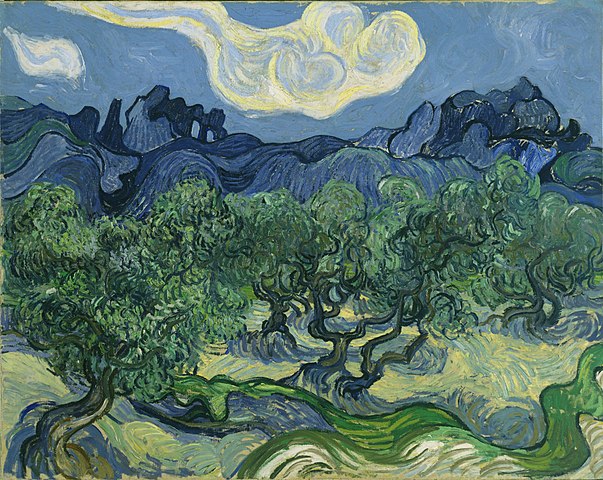
Van Gogh struck again with this curvaceous work representing, as so often, Mediterranean landscapes, in particular those of Provence. This painting, almost psychedelic, transports us to his dreams and his imagination, inspired by the myths of Provence. The olive trees, lost and confused with the garrigue, thanks to a shades of green, tickle the sky and the clouds, under a chain of blue mountains, the Alpilles. Each element of nature seems to intertwine and become one. Intermingling reinforced by the volute motif which marks the whole and which may have been inspired by the painter both by the clouds and the crooked shape of the olive trees. As in many of his works, Van Gogh transforms reality and escapes the standards of realistic painting of the time, to offer us his own vision of everyday life.
Italian landscape seen through a skylight, Edgar Degas (1856-1859)
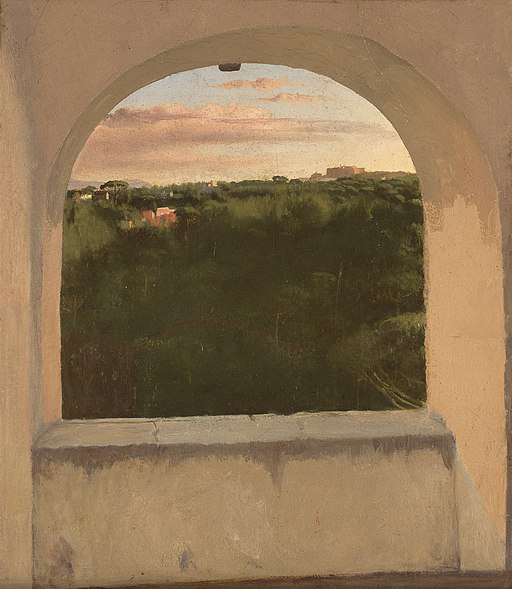
Landscapes of Italy seen through a skylight by Edgar Degas is a mise en abîme, a veritable painting within a painting. Indeed, the skylight surrounding the landscape of Italy structures the green spectacle of nature and the cloudy sky which overhangs the whole. The shadow play used to paint the skylight marks the temporality of this work, surely representing the end of a summer day. This painting is reminiscent of the hottest time of the year for its palette of soft, rosy and elaborate, almost shy colours, which magnify an almost sleeping Italian landscape, where clouds and dark blue sky intermingle. The imposing skylight frames the landscape, guiding the viewer’s sense of reading. French artist, painter, engraver, sculptor, photographer and naturalist, Edgar Degas has more than one string to his bow and we recognize the precision of the photographer’s angle in this portrait of Italy. Founding member of the Impressionist movement, this influence shines through in this work where the play of lights outdoors is the main object of the painting. An unconventional artist, his works are varied and, according to him, when it comes to painting landscapes he prefers “Cand that we only see in his memory” and this is perhaps what the artist wanted to represent by framing Italy in this skylight.
See as well

Breakfast-Time, Hanna Hirsch-Pauli (1887)
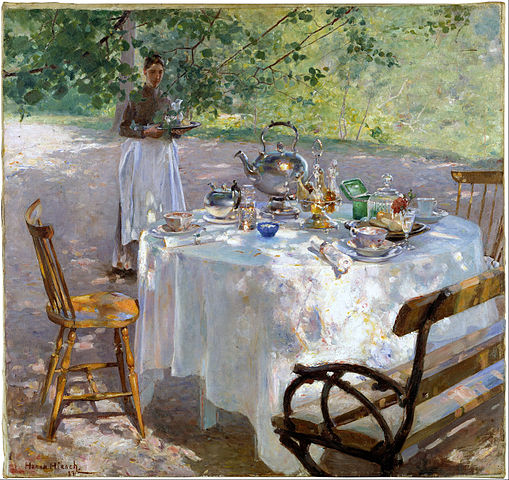
Hanna Hirsch-Pauli paints a scene of life, simple but strikingly realistic. A Swedish painter of the 19th century, she stands out for her style which consists in taking as models only artists and people she knows personally – in particular her husband – which gives relief and intimacy to her art. In his table Breakfast-Time, Hanna Hirsch-Pauli illustrates a lunch outside, in the countryside, accompanied by a young woman alone, in a dress, bringing a tray. The table – central element of the work – is surrounded by three empty seats, ready to welcome guests. Dressed all in white, the round table is placed under a tree, which we can guess thanks to the play of shadows and the work of light in the form of small white and black spots which sparkle even on the teapot. The leaves of the tree overhanging the table are painted delicately, with light touches, which gives softness to the picture. The varying shades of green used to paint the nature and landscape surrounding the main scene create depth and provide elements of context in this peaceful scene. By painting this work, Hanna Hirsch-Pauli recalls summer meals, frugal and convivial.
All works in the article are in the public domain. The reproductions are free of rights and come from Wikipedia Commons.
We want to say thanks to the author of this post for this outstanding material
(Re)fall in love with summer in 5 scenes | LeMagduCine
Our social media profiles here and other pages related to them here.https://nimblespirit.com/related-pages/

